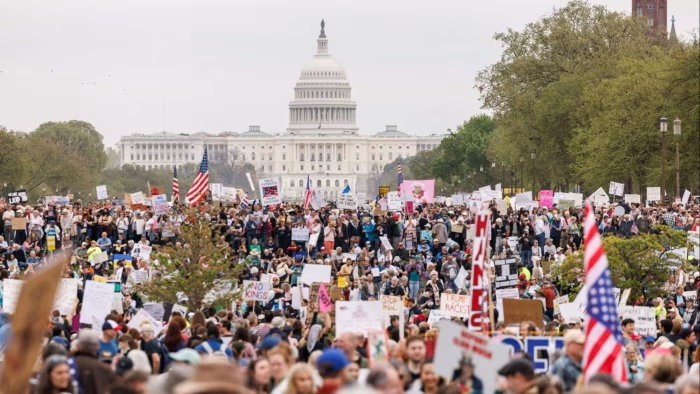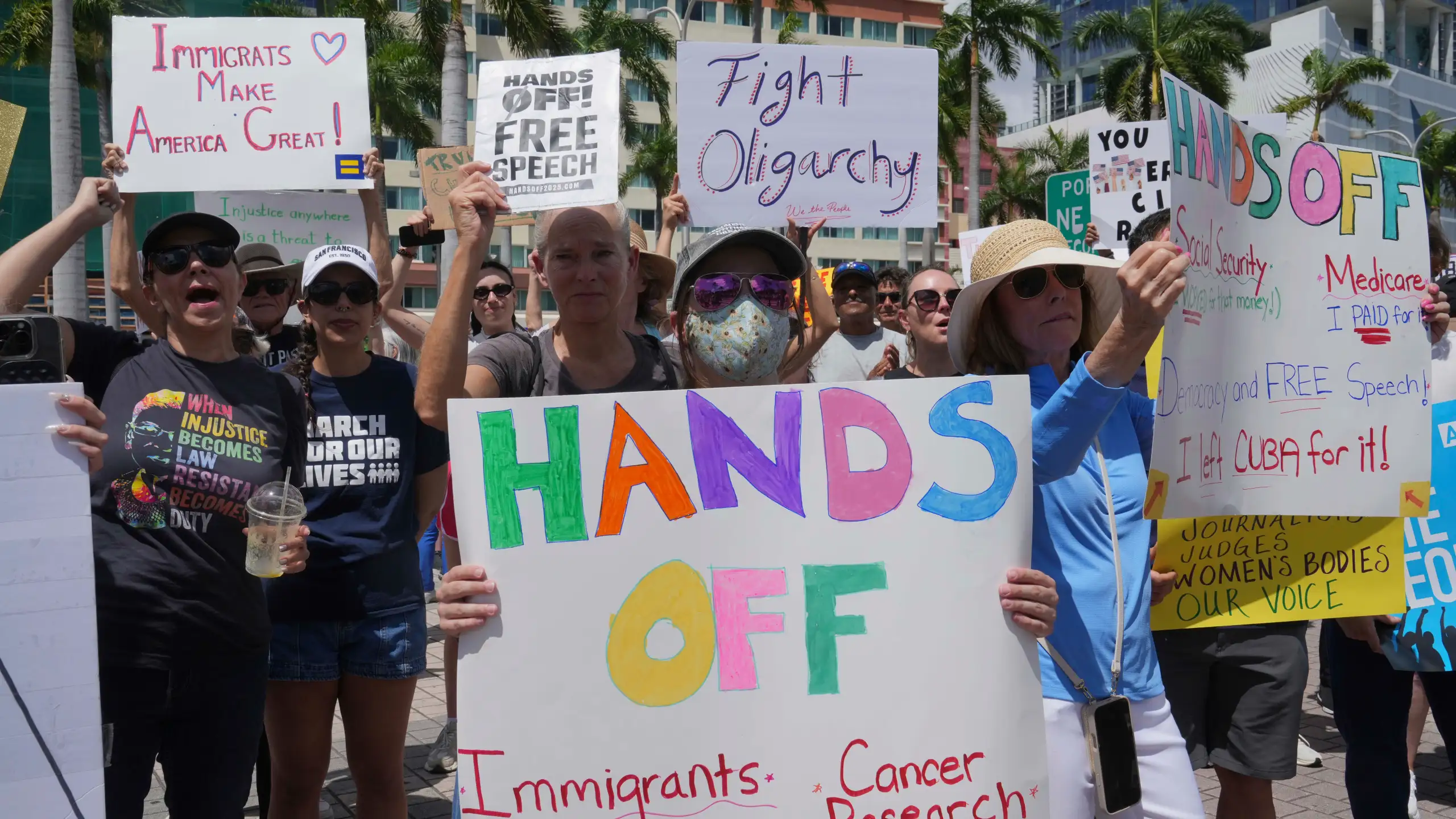April 6, 2025
 On April 6, 2025, the “Hands Off” protest marked a pivotal moment in political activism as over 1,300 demonstrations took place across the United States and worldwide. Fueled by concerns about federal cuts proposed by President Donald Trump and Elon Musk, these rallies were orchestrated by more than 150 civil rights, labor, and LGBTQ+ advocacy groups. In major U.S. cities like Washington, D.C., New York City, and Chicago, thousands came together, voicing their opposition to what they deemed as “illegal, billionaire power.” Notably, the Washington, D.C., rally alone drew over 100,000 participants. Meanwhile, the solidarity extended beyond U.S. borders, with international protests in places like Berlin and London highlighting global discontent. These widespread demonstrations underscored the universal call for fairness and transparency.
On April 6, 2025, the “Hands Off” protest marked a pivotal moment in political activism as over 1,300 demonstrations took place across the United States and worldwide. Fueled by concerns about federal cuts proposed by President Donald Trump and Elon Musk, these rallies were orchestrated by more than 150 civil rights, labor, and LGBTQ+ advocacy groups. In major U.S. cities like Washington, D.C., New York City, and Chicago, thousands came together, voicing their opposition to what they deemed as “illegal, billionaire power.” Notably, the Washington, D.C., rally alone drew over 100,000 participants. Meanwhile, the solidarity extended beyond U.S. borders, with international protests in places like Berlin and London highlighting global discontent. These widespread demonstrations underscored the universal call for fairness and transparency.
Overview of the ‘Hands Off’ Protests
The “Hands Off” protests are a significant movement occurring on April 6, 2025. These protests are organized in response to federal cuts by President Donald Trump and industrialist Elon Musk, with a vast network of civil rights, labor, and LGBTQ+ advocacy groups spearheading the initiative. The protests have resonated far and wide, symbolizing a collective stand against perceived injustice and power imbalance. Let’s delve deeper into their purpose and scale.
Purpose and Organization of the Protest
Involvement of Civil Rights Groups
Civil rights groups have played a pivotal role in organizing the Hands Off protests. These organizations have long been champions for social justice, advocating for equality across race, gender, and sexual orientation. Their participation in the protests reflects a desire to challenge and oppose policies that may be considered inequitable or detrimental to marginalized communities. More than 150 groups, including labor and LGBTQ+ advocates, have joined forces to ensure that voices advocating for fairness and inclusion are heard loud and clear. This collaborative effort underscores the importance of unity and solidarity in the face of policies perceived as oppressive.
Targeting Trump and Musk
 The protests specifically target President Donald Trump and Elon Musk due to their roles in driving the federal cuts and their overarching influence. Protesters accuse both figures of upholding what they describe as an “illegal, billionaire-powered” agenda, where economic and corporate interests overshadow the needs of ordinary citizens. By concentrating their efforts on these two prominent figures, protesters aim to draw attention to the vast disparities between the privileged and the underprivileged, as well as to critique the administration’s approach to social and economic issues.
The protests specifically target President Donald Trump and Elon Musk due to their roles in driving the federal cuts and their overarching influence. Protesters accuse both figures of upholding what they describe as an “illegal, billionaire-powered” agenda, where economic and corporate interests overshadow the needs of ordinary citizens. By concentrating their efforts on these two prominent figures, protesters aim to draw attention to the vast disparities between the privileged and the underprivileged, as well as to critique the administration’s approach to social and economic issues.
Timing and Scale of the Protests
Date and Global Scope
April 6, 2025, marks the significant date when more than 1,300 “Hands Off” protests erupted not just across the United States but globally. The chosen date is a declaration of resolute opposition against the actions of the Trump administration and the influence of tech mogul Musk. This demonstrates the widespread influence of American policies, stirring international concern and prompting rallies from Berlin to London, and beyond. These protests underline that the issues at hand are not confined to the U.S. alone but resonate with global citizens who share a passion for justice and equality.
Number of Protests and Participants
The immense scale of these protests is evident in the sheer number of events: over 1,300 protests took place on a single day. These protests drew a diverse crowd of participants, uniting hundreds of thousands of individuals under a single cause. From large metropolitan cities like New York and Washington, D.C., to smaller towns and international capitals, participants collectively voiced their dissent. The massive turnout serves as a testament to the power of mobilization and the enduring human spirit in standing up for what is perceived as right and fair. Such participation highlights the profound impact of collective action and advocacy, striving to drive change in policies and practices that affect the global community.
Major U.S. Cities with Significant Protests
The “Hands Off” protests witnessed a significant presence in major U.S. cities. These cities became hotspots for activism as citizens voiced their dissent against the federal cuts initiated by President Donald Trump and Elon Musk. Here’s an in-depth look at how the protests unfolded in some key locations:
New York City, NY
Scale and Key Figures
New York City, known for its activism, saw a massive turnout. Thousands packed the streets, showcasing the city’s role as a pivotal stage for political expression. Key local figures and activists joined to emphasize the city’s collective resistance against the perceived “billionaire power” influence on federal policies. Notable community leaders and celebrities were present, adding weight to the movement.
Media Coverage
The media extensively covered the New York City protest, with major outlets in attendance, bringing the national spotlight to the city’s demonstration. Channels and newspapers provided live updates, interviews, and in-depth analysis, reflecting the strong sentiment of the city’s residents.
Washington, D.C.
Crowd Size and Influential Speeches
Washington, D.C., being the heart of U.S. politics, saw more than 100,000 participants in its protest. The event was intensified by influential speeches from various activists, which captivated the audience and heightened the rally’s impact. The city’s protest aimed to speak directly to those in power, making it a focal point of the national movement.
Impact of Immigration Activist Speeches
Immigration activist Greisa Martinez Rosas delivered a powerful speech, resonating deeply with the crowd. Her words emphasized the critical issues faced by immigrant communities, calling for change with urgency and vigor. Her influence was palpable, with many rally-goers finding renewed inspiration to continue their advocacy efforts.
Chicago, IL
Public Sentiments and Issues
Chicago’s protest brought thousands of participants who expressed their concerns over various federal policies. The rally highlighted local economic and social issues, with citizens openly discussing the cuts’ impact on their lives and communities. This gathering reflected the pressing issues faced by the city’s residents.
Local Response and Media
Media presence was strong in Chicago, with local outlets providing comprehensive coverage of the protest. The emphasis was placed on public opinion and the demands being made to the federal government, ensuring that the voices of Chicagoans reached a wider audience.
Boston, MA
Objectives of the Protest
In Boston, demonstrators clearly articulated their opposition to the administration’s actions. The primary focus was on protecting social programs and ensuring that federal policies do not adversely affect marginalized communities. Boston’s history of activism fueled the protest’s objectives, aligning them with broader national goals.
Participant Views and Voices
Participants in Boston were vocal, sharing personal stories and viewpoints that underscored the need for change. The city’s strong tradition of civic engagement was evident, with many expressing a determination to uphold justice and equality.
Milwaukee, WI
Community Concerns and Atmosphere
Milwaukee’s protest reflected community concerns over the direction of national policies. The atmosphere was charged with emotion as residents articulated their fears and frustrations. Protesters called for better engagement with local issues within the broader national context.
Regional Engagement
Regional media highlighted Milwaukee’s engagement with these national debates, emphasizing the city’s active role despite its smaller size compared to other major cities. This engagement demonstrated the depth of concern and the resolve to demand action.
Riverhead, NY
Participation in Smaller Towns
Even smaller towns like Riverhead saw significant participation. This underscores the widespread reach and influence of the protests beyond the urban epicenters. The town’s involvement highlighted that the movement was nationwide and ubiquitous.
Local Initiatives and Impact
Local initiatives in Riverhead took shape during the protest, leading to a deeper community impact. Residents organized events and discussions, aiming to forge stronger ties and a united stance on pertinent issues.
Manhattan, KS
Demonstrations and Local Reactions
In Manhattan, Kansas, demonstrations took place, illustrating the local reactions to national policies. The presence of impassioned demonstrators indicated that even the heart of the Midwest was not immune to the call for accountability and reform.
Community’s Concerns
The community’s concerns were transparent, focusing on the necessity for economic stability and inclusivity. Demonstrators in Manhattan pointed to specific policies affecting their livelihoods, aiming to foster broader understanding and support.
These carefully orchestrated rallies showcased not only dissatisfaction with specific policies but also unified a diverse array of voices across the nation, each echoing the call for a more equitable and just governance.
International Protests Reflecting Global Solidarity
The International Protests against U.S. policies and actions, as viewed in the “Hands Off” rallies, underscore a global resonance that extends beyond American borders. From Berlin to London, these events reflect a worldwide echo of dissent and concern over the overarching impacts that transcend national boundaries.
Berlin, Germany
Berlin, Germany, served as one of the central hubs for these international demonstrations, drawing a significant crowd that resonated with the values and urgencies echoed by their counterparts in the U.S.
Themes and Key Messages
In Berlin, the protests were anchored in themes of human rights, equality, and resistance against perceived injustices stemming from billionaire influence in governmental policy. Protestors emphasized slogans such as “Democracy Not Plutocracy” and “Solidarity Across Borders,” highlighting a commitment to shared global values amidst various geopolitical challenges. The key messages extended an aura of unity among disparate groups to confront shared adversities collectively.
European Perspective on U.S. Policies
The European Perspective on U.S. Policies expressed during the Berlin demonstrations encapsulated a fear of autocratic trends and economic policies seen as detrimental to global cooperation and fairness. European citizens and leaders voiced their trepidations over U.S. policies, particularly in areas concerning climate, trade, and human rights. There was a pronounced call for strengthening international alliances to combat populist and authoritative strategies perceived to be spreading worldwide.
London, UK
London, UK, mirrored the fervor found in Berlin, adding its distinctive voice to a choir of global dissent, emphasizing the interconnectedness of modern sociopolitical landscapes.
Demonstration Highlights
In London, protestors filled the streets with banners that read “Global Voices, United Choice” and “Empower the People, Not the Tycoons,” shining a spotlight on a strong aversion to economic disparity and political corruption. The highlight of the demonstrations included speeches by prominent activists and community leaders who urged for unity and action against policies believed to favor the elite few over the many, promoting a vision of inclusive governance.
Expressions of Global Concern
Expressions of Global Concern in London illustrated a deep awareness and solidarity with marginalized communities worldwide. Participants expressed worries about the billionaire power structures at play, not just within U.S. borders, but as a growing trend seen as eroding democratic institutions internationally. The calls for a shift towards sustainable policies and responsible governance resonated strongly with audiences and underscored the necessity of global vigilance and advocacy.
These international protests affirm that issues of governance, equality, and justice are interlinked across continents. As participants from cities like Berlin and London demonstrate their solidarity, the lasting impact of the “Hands Off” protests may serve as a catalyst for global change.
FT
